British Decorative Arts Galleries, The Metropolitan Museum of Art, New York
Reviewed by Elizabeth A. PergamElizabeth A. Pergam
Co-Chair, Society for the History of Collecting
Email the author: eapergam[at]gmail.com
Citation: Elizabeth A. Pergam, installation review of British Decorative Arts Galleries, The Metropolitan Museum of Art, New York, Nineteenth-Century Art Worldwide 21, no. 3 (Autumn 2022), https://doi.org/10.29411/ncaw.2022.21.3.12.
This work is licensed under a Creative Commons Attribution-NonCommercial 4.0 International License  unless otherwise noted.
unless otherwise noted.
Your browser will either open the file, download it to a folder, or display a dialog with options.
Officially opened to the public in early March 2020 after a closure of four years, only to shut down days later with the rest of the Metropolitan Museum of Art and New York City, the ten galleries that comprise the encyclopedic museum’s rooms dedicated to the decorative arts, design, and sculpture of Britain from 1500 to 1900 have been reimagined both conceptually and materially by the curators of the European Sculpture and Decorative Arts Department and the New York design firm of Roman and Williams.[1] The pedagogical support incorporates questions of labor, production, and consumption that have been foregrounded in recent art historical studies; the dramatic use of lighting, display cases, and architectural surrounds enhances the visual appeal of objects whose style and function might seem remote to today’s museum visitors. Both of these concerns are indicative of a notable shift in the position of the decorative arts at the Met, as well as the curators’ sometimes idiosyncratic choices in the display of this type of material.[2]
For many, the portraits of Sir Joshua Reynolds and Thomas Gainsborough and the landscapes of John Constable and J. M. W. Turner represent British art; stronger collections of paintings and drawings are held by the Yale Center for British Art in New Haven, CT, and the National Gallery of Art, Washington, DC, both of which owe their excellence to the Mellons—Andrew and his son Paul. Neither of these museums, however, have significant collections of three-dimensional objects representative of the material culture of Britons over the course of several centuries.[3] The California collection of Henry E. and Arabella Huntington combines significant holdings of British paintings with an extensive collection of British decorative arts, but it is displayed in the context of a house museum and the original collection was largely assembled through one dealer—Joseph Duveen.[4] The Met, therefore, is in the best position to use its strength in decorative arts to expand visitors’ understanding of the objects amongst which the sitters in many of these portraits lived.
The establishment of the South Kensington Museum (SKM, now the Victoria & Albert Museum) in London in 1852 cemented the status of the applied arts as museum worthy and had a direct impact on the founding of the Metropolitan Museum of Art less than two decades later. Thus, while the Met’s greatest strength in this area lies in works from the eighteenth century, these galleries owe their existence to a nineteenth-century British innovation in museology. Because the SKM’s raison d’être was to provide examples of the best design (as well as examples of what was to be avoided) in order to improve the quality of British manufactures,[5] Henry Cole, its visionary first director, advocated for the organization of the objects by material. Aspiring modelers at the Chelsea manufactory could examine an array of objects made of porcelain or ceramic. Although a similar impetus could be seen in the early history of the Met, its implementation was inevitably shaped by other, more local concerns, not least of which was the fact that the museum has always been dependent on the interests of its donors in the formation of the collection. This history is expertly laid out in Max Bryant’s essay in the issue of the museum’s quarterly Bulletin published to coincide with the 2020 opening.[6] Curatorial choices in this reinstallation can, therefore, be understood as a reflection both of new trends in recent scholarship in the decorative arts, and new ideas about how to appeal to the museum’s ever-changing audience.
These “new” galleries make a sharper distinction between those that recreate three English historic interiors—all of which date from the second half of the eighteenth century—and the other galleries, affording opportunities to explore questions of materials and craftsmanship; the occasional inclusion of less costly objects introduces issues of consumption beyond the confines of aristocratic town and country houses and differs from the treatment of these rooms in the previous renovation completed in 1995.[7] The installations brought together furniture, paintings, and objects in grand private settings, extending the idea of aristocratic living conveyed by the two rooms from English country houses and an important London townhouse. Material associated with the Victorian period was mostly absent. Now, atmosphere is created with dramatic lighting, sleek display cases, and lively wall texts, and more real estate is dedicated to the nineteenth century.[8]
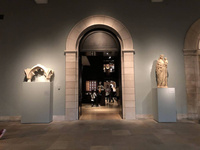
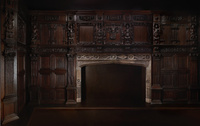
The intended chronological progression begins with the sixteenth century, leading from the central medieval sculpture hall and forging a connection between the sculptures and tapestries installed in the original 1880 core of the Fifth Avenue building.[9] Moving from the soaring, stone-clad court to a narrow, dimly-lit space whose deep purple walls read as nearly black, the architectural transition is abrupt (fig. 1). Pinpoint lighting draws our attention to six alabaster sculptures characteristic of the Nottingham School from the mid-fifteenth century depicting scenes from the life of Christ. These fragments, some of the very few religious objects in the entire suite of galleries, together with the newly conserved polychromed terracotta bust of the Bishop John Fisher by Italian sculptor Pietro Torrigiano, are reminders that England was a Catholic country before Henry VIII established the Church of England as part of his matrimonial maneuverings.
Henry’s adoption of Protestantism is often cited as a prerequisite of the island nation’s mercantile success. The curators adopt this emphasis on the country’s “entrepreneurial spirit,” which is articulated in the introductory wall text (as well as the title, “A Nation of Shopkeepers,” of Burchard’s Bulletin essay). Its declarative first sentences—“Creative risks. Artistic choices. Leaps of imagination and ventures for profit”—insert a dramatic cadence that serves as a verbal parallel to the theatrical strategies employed in the surrounds. For example, the label that describes the intricate paneling commissioned by William Crowe, bailiff of Yarmouth, Norfolk, for his house on the Hall Quay around 1600 is titled “New Money.” The elaborate carving (difficult to see in the low light) includes the coat of arms of the Company of Spanish Merchants, of which Crowe was a member (fig. 2). This early example of a trading company that had strong links with the Low Countries, still under Spanish rule, was an important source of wealth for merchants of East Anglia dating back to before the establishment of the Church of England.
Also in this first gallery are objects of everyday and more select use, ranging from silver trenchers and Apostle spoons to stoneware. A wall label titled “Hierarchy” introduces drinking vessels intended for three ranks of society visualized in this installation by their placement in the case: on the top shelf, to symbolize their use by the highest level of society, the gilded-silver flagons for wine from the Paston Treasure; silver-mounted stoneware tankards on a middle shelf; and green-glazed jugs on the lowest shelf reflecting their use in less exalted households. The details of the dolphins and shells of the ornate wine vessels on the top shelf are difficult to examine in this arrangement. The Metropolitan’s upcoming exhibition The Tudors: Art and Majesty in Renaissance England (opening on October 10, 2022) will be an excellent opportunity to rectify the relative dearth of material from the late fifteenth and sixteenth centuries in both the paintings and decorative arts departments.
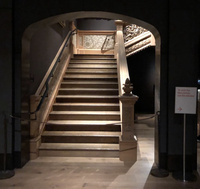
“British” is a misnomer for the art of this early period as it was not until the Act of Union in 1707 that England, Wales, and Scotland became the United Kingdom of Great Britain.[10] How national identity is expressed through objects often made by foreign-born artisans is an important recurring theme in the galleries, with England often serving as a place of refuge for displaced craftsmen seeking religious tolerance, most notably the Huguenots expelled from France after Louis XIV revoked the Edict of Nantes in 1685. Another aspect of how decorative arts might reinforce or complicate our understanding of national identity are the materials artisans chose to use; the curators are adept at drawing attention to the implications of material—whether “native” such as alabaster, or imported, such as ivory, mahogany, or raw materials for textiles, such as cotton, that signaled the reach of British trade and imperial ambitions. The continued importance of oak, a readily available, very strong wood, to English interiors is represented by the repositioned and restored late seventeenth-century staircase from Cassiobury Park. It was once thought to be the work of Dutch-born Grinling Gibbons, the most prominent carver of this period, but is now attributed to Edward Pearce. The new installation makes it visible to visitors, but it is cordoned off; the balcony it leads to is accessible by elevator (fig. 3).
Because of the limited dimensions of this space, the monumental figures of the large tapestry The Destruction of the Children of Niobe (ca. 1650–70), designed by Frans Cleyn for the Mortlake tapestry factory in the middle of the seventeenth century, are best viewed from this balcony. To have three important, if very different, examples of tapestry—a manufacture associated with the textile trade that was so fundamental to English wealth—in close proximity to one another provides a welcome opportunity to compare scales, styles, subjects, functions, and patronage.
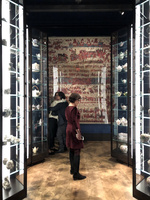
The same constriction of space is especially acute in the case of the tableau displaying the magnificent State Bed from Hampton Court (ca. 1698) in Herefordshire, its design reflective of the influence of the French-born architect Daniel Marot. More like a passageway than a gallery to contemplate the inlays of the cabinet on stand or the remarkable chasing of the silver vases arrayed atop it, this installation could easily be passed through too quickly as the visitor is propelled forward to the dazzling display cabinets of stoneware, soft-paste porcelain, and silver objects connected to the rituals of tea and to the period in which the strength of the museum’s collection lies (fig. 4).
Typical of the questions that frame many of the text panels are those that address the visitor in “Tea, Trade, and Empire”: “How did an ancient Asian tradition become something quintessentially British?” The answer provided on the wall text is that the 119% tax was reduced to 12.5%, making what had been a luxury more widely available. Yet the Commutation Act instituting this sharp reduction was not passed until 1784, and tea was readily available prior to that date. This gallery displays an array of tea-related items in two cases, each nine shelves high, that tower over the visitor; the cases’ bright side lighting leaves the rest of the room in shadow. Inevitably, the examples on the top shelves are impossible to examine—implicitly giving the visitor the impression that these objects are less important in and of themselves than as part of an impressive whole. Individual labels, relegated to a booklet held in a wall pocket, reveal that much of the tea paraphernalia on view date to well before the passage of the Commutation Act. The cultivation of tea and Britain’s trade with the countries that produced it prompted a fundamental shift not only in social mores, but in the manufacturing of objects connected to these new rituals of tea serving and drinking. As tea and its attendant rituals are so closely associated with Britishness, even today, it might have been represented more fully, beyond the spectacle of the vast quantity of pots (and cups).
At the corners of this room are overly large cases that contain small objects, some made of materials that illustrate Britain’s colonial reach, which extended to India (ivory), China, Jamaica (tortoiseshell), and the Americas.[11] The tiny antislavery medallion manufactured by Josiah Wedgwood, at whose factory many of the tea sets were produced, embodies the contradictions of eighteenth-century British prosperity arising from colonial expansion and exploitation. Wedgwood has been held up as an exemplar of the entrepreneurial spirit of Georgian England; his advocacy of abolition is represented by medallions which were distributed for free at meetings, but he made dishes that contained tea, sugar, and other commodities whose cultivation was made possible through the labor of enslaved or indentured people.
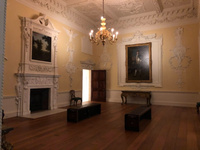
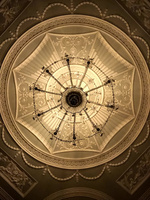
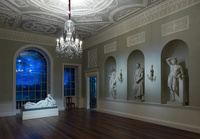
From this pivotal room the visitor may enter the sparsely furnished dining room from Kirtlington Park (designed by John Sanderson in 1749) or continue forward into the brightly lit, long Gallery 512. The ornate stucco that decorates the pale-yellow walls of the dining room of Sir James Dashwood’s country seat in Oxfordshire, dating from 1748 and given to Thomas Roberts,[12] is an expression of the floral exuberance of the rococo style adapted to the British country house interior. In an earlier installation, the link to the European rococo was made by the hanging of two François Boucher pastoral scenes set within the plaster frames, one of which is now empty and the other awkwardly accommodating a full-length portrait of Sir James Dashwood by Enoch Seeman the Younger (fig. 5).
Dating from 1766–69, just twenty years after Kirtlington Park, the Lansdowne House dining room (designed by Robert Adam), accessed through Gallery 512, shows how rapid the shift was from the serpentine curves of rococo ornamentation to the pared down linearity of neoclassicism. Adam was commissioned to supply the designs for the town house of William Petty Fitzmaurice, second earl of Shelbourne (created Marquis of Lansdowne in 1784). The dining room exemplifies that numerous specialist craftsmen were involved in such a grand architectural commission, with Joseph Rose responsible for the plasterwork ceiling (fig. 6) and John Gilbert for the wood carving (information we know from the existence of invoices) to name just two.[13] Again, as a contrast to the fulsome groupings of objects in the galleries, this period room is notable for its restraint. Thus, in the past, a carpet and dining table and chairs had been placed at the center and side tables and chairs punctuated the walls; today, there is an abandoned feeling to the room (fig. 7). While James Boyd’s moonlit scene of Berkeley Square seen through the windows provides the context for the time of day at which the dining room would have been at its most populated, this townscape also suggests a ghostly absence.
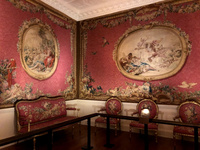
Adam’s use of classical motifs in the design for the plasterwork ceiling and splendid French furnishings and wall tapestries of Croome Court, Worcestershire, date from the 1760s, demonstrating the impossibility of a strict dividing line between neoclassicism and the rococo. A perfect example of “French Luxury,” a title given to the grouping of gilded objects in the main Gallery 512, the tapestries that line the walls and cover Ince and Mayhew chairs and settees were acquired by George William Coventry, sixth earl of Coventry from the Royal Gobelins Manufactory, which he had visited while in Paris in 1763. With scenes of the four elements woven to designs by Boucher, seat covers designed by Maurice Jacques (fig. 8), a frieze by Joseph Wilton, paneling carved by Sefferin Alken, and works by numerous others, the room exemplifies the cross-cultural collaborations that enabled the creation of these aristocratic interiors. Other furniture from Croome Court is easier to examine closely in two of the arrangements in Gallery 512: included in the group “French Luxury” is the commode designed by Peter Langlois for one of the bedrooms; the mirror and console table for the earl’s country house that were designed by Adam but carved by Danish-born Alken are given the hyperbolic label heading “Hired Gun.”
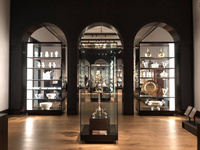
This well-lit long gallery serves as the setting for thematic groupings of objects, such as “The Near and Far East,” “Ceremonial Silver,” “Local Might,” and the aforementioned “French Luxury.” In keeping with current academic approaches that deemphasize the narrative of successive styles and connoisseurship associated with their evaluation, the galleries are not meant to be a visual lesson in the strictly chronological evolution of ornament and design. Furniture is set against the walls while large, glass-enclosed display cases are either centered or used as room dividers (fig. 9). A number of important acquisitions have been made, including the silver japanned secretary cabinet, its elaborate treatment intended to replicate fashionable, but more expensive, Asian lacquer. Representing the opposite pole of ornamentation is the writing table attributed to William Vile, whose subtly curved profile and minimal carving exhibit a moderation that contrasts with the neighboring medal cabinet commissioned from the cabinetmaker by George III when he was Prince of Wales. Along with the marble-topped table attributed to Matthias Lock and the mantelpiece from Chesterfield House attributed to John Michael Rysbrack, these large statement pieces are associated with the wealthiest patrons and primarily located in English (as opposed to Welsh, Scottish, or Irish) houses.
The increasing prosperity of a growing middle class, however, had profound implications for the types of objects produced in the eighteenth century. Scholarship investigating the rise of consumer culture associated with Britain in this period, adopted from literary criticism and the social history of art, has had a direct impact on studies of the decorative arts.[14] There remains nonetheless a disinclination to address directly specific questions of cost and market. A tour-de-force of installation is the large glass case in which 113 smaller scale objects designated as “Toys and Trinkets” are arrayed. Enamel snuff boxes, silver salvers, porcelain scent bottles, and shoe buckles represent what the curators term “The Seduction of Retail.”[15] While the labels indicate that objects, such as the nécessaire produced in the workshop of watchmaker James Cox, were for the very wealthiest, there is little information about the cost of this jewel-encrusted, moss agate box with gold mounts in relation to, for example, the typical income of its intended customer or the less expensive items displayed around it.[16]
Much progress has been made in identifying the previously anonymous craftsmen who executed the stucco, carved the oak, and modeled the porcelain figurines. For example, there are numerous examples of the work of Joseph Willems, a Flemish modeler who worked for the Chelsea manufacturer. Another area the study of the decorative arts has advanced in recent years has been in bringing to the fore women as designers and as consumers. This new understanding of the role of women is less apparent in the museum’s galleries. There are just a handful of examples of works designed or executed by women: three lengths of silk woven to a design by Anna Maria Garthwaite; the bust of Elizabeth I made from Coade stone (fig. 10), an artificial material developed by Eleanor Coade; and the charming marble sculpture of a Maltese dog by Anne Seymour Damer (fig. 11). Royal women as patrons appear periodically: Catherine of Braganza commissioned the tapestries depicting Don Quixote for an extravagant gift; two swathes of velvet are based on furnishing upholstery commissioned by Queen Anne for Windsor Castle. Queen Victoria is represented in the form of medals, including a large double portrait representing her at eighteen, the age she assumed the crown in 1837, and sixty-eight on her Golden Jubilee in 1887. The most visible presence of women is as the subject of painted and sculpted portraits, such as Sir Joshua Reynolds, Mrs. Lewis Thomas Watson (Mary Elizabeth Milles, 1767–1818) (1789), George Romney, Lady Elizabeth Stanley (1753–1797), Countess of Derby (1776–78), and Camillo Pistrucci, Mary Shelley (1797–1851) (1843).
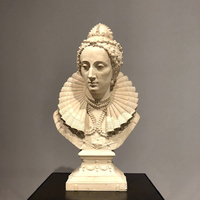
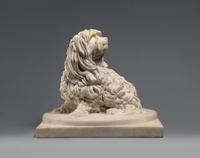
At times, the arrangements are particularly fanciful, as in the hanging of iron balustrades around the doorway that leads out of the Lansdowne dining room (fig. 12). Are they on view to exemplify the variety of design motifs, from the serpentine, floral shapes from the 1730s to the more antique references of balusters dated to the 1770s? Or do they represent how design was applied to even the most utilitarian materials? Might this be an instance of the English humor to which Burchard refers in his Bulletin essay? No explanation is provided for where these functional but design-conscious objects come from or how they were used. Iron would become the quintessential structural support for the innovative architectural idiom of the glass and iron palaces of mid-nineteenth-century exposition spaces.
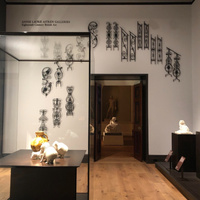
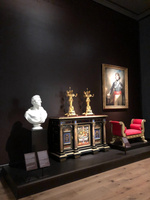
In anticipation of the reopening and in recognition of its comparative weakness in examples from the nineteenth century, the Met has made significant acquisitions for the final rooms of the suite named after Josephine Mercy Heathcote.[17] The nineteenth-century material is introduced by a tableau of ornate works dating from the Regency period effecting the transition from Gallery 512 (fig. 13). Sir Francis Chantrey’s bust of the Duke of Wellington on the left and on the right a workshop portrait of George Augustus Frederick, the eldest son of George III whose position as Prince Regent gave this period its name, bookend three examples of the most extravagant expressions of wealth available to early nineteenth-century Britons. Without doubt the cabinet (one of a pair), currently on loan from Mr. and Mrs. Lockwood Chiltern, is one of the most opulent objects on view. Attributed to the British cabinet maker Robert Hume and dating around 1825, it is composed of seventeenth-century hardstone panels probably from France and Italy. The complexity of its construction and the variety of materials stand as a reminder that periodizing and categorizing works such as this one involves knowledge much beyond merely the name of a single artist or medium.
If approaching from the American Wing, the Heathcote suite provides an alternative entrance to the British galleries.[18] With their dark walls and Gothic Revival arches, these spaces echo the historicism that characterized many design movements of the Victorian period, as well as refer back to the first galleries in the sequence. Examples by Augustus Welby Northmore Pugin—best known as the designer of the interiors for the Gothic Revival Palace of Westminster, otherwise known as the Houses of Parliament—remind us that design revivals are often connected to religious and political developments, in this case, the Oxford Movement. Thus, the long-held association of the adoption of Protestantism with the rise of trade and profit, introduced already in the gallery dedicated to the sixteenth century, is clearly in need of revision.
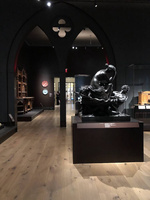
Although examples of British sculpture—primarily portrait busts—punctuate the entire suite of galleries (often in recessed display cases), their presence is felt more startlingly in these spaces. Especially powerful is the bronze group of Thetis Transporting Arms for Achilles (ca. 1804–12, fig. 14) by William Theed the Elder. From a family of British sculptors, the name Theed would have been familiar to the late eighteenth- and nineteenth-century British exhibition-goer but is largely unknown in the United States. The subject is from the Iliad but has contemporary overtones—alluding to the death at the battle of Trafalgar of Admiral Nelson—and serves in these galleries as a reminder of the profound impact of the Napoleonic Wars on Britain both economically and artistically. Britain’s eventual triumph over its cross-channel rival predicated its imperial dominance in the century to follow.
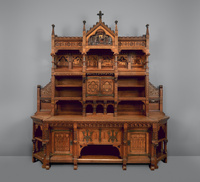
In the context of design and style, Victoriana often conjures overly ornamented, heavy furniture, and a horror vacui. The objects selected for the Heathcote Gallery avoid these characteristics. Victoria’s long reign is typically divided into several periods, with the mid-Victorian period in which the SKM was founded arguably the most overlooked. The quarter century of her reign after she was named Empress of India is the most appealing to scholars of imperialism and post-colonialism. Nevertheless, many of the objects arrayed in the cases of the Heathcote Gallery are connected in some way to the trend of objects designed to gain visitor attention at the world’s fairs initiated by the Great Exhibition of 1851 and continued by the 1853 Dublin exhibition, the 1855 Exposition Universelle in Paris, and its successors. With a wall to itself, the elaborate, oaken Pericles Dressoir (fig. 15), designed by Bruce J. Talbert for the firm of Holland & Sons and exhibited at the International Exhibition in Paris in 1867, would have been used to display objects similar to those now in the new glass cases showing the work of manufacturers, such as Worcester and Minton, and designers, such as Christopher Dresser.[19] The intricate inlays and metalwork, the scene from Shakespeare’s Pericles, Prince of Tyre (1609) carved in the top gable, and the quotation from Act 2, scene 3 of the play are a feast for the eyes. However, like the Lansdowne dining room, how the sideboard would be used is left to the visitor’s imagination.
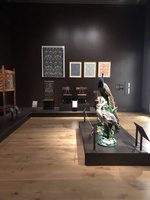
The industrialization that began in the eighteenth century expanded and, in many ways, defined the nineteenth. No figure embodies the contradictions of the availability of machine-made products better than William Morris, whose daughter May was also an adept designer but who remains absent from the galleries. Several of Morris’s still recognizable designs for wallpapers and textiles are displayed (fig. 16). Here would have been an obvious place to address the designer’s socialist politics, his aspirations for good design available for all, and the expense of designing and making high quality household objects that inevitably placed the products of Morris & Co. out of reach for most people. While his social and economic thought was revolutionary, he also advocated for the preservation of heritage and was the leading force behind the Society for the Protection of Ancient Buildings. Morris is, therefore, a model for how to embrace social justice at the same time as recognizing the useful lessons of the past. While the label refers to Morris’s belief that good design and quality execution were important for the craftsman’s “pride,” concern about artisans’ exposure to examples of design that should be emulated were fundamental to the establishment of the museum which provided a model for the Metropolitan.
Curiously, there is only one, fleeting mention of the SKM in this gallery of nineteenth-century British art, even though the Great Exhibition, which inspired it, is identified as central to this period.[20] In late 2001, the V&A opened their own remodeled galleries dedicated to the arts of Britain. With their access to a wider range of objects and an audience more familiar with the historical background, it is, admittedly, an unfair comparison. Closer to home, just a short walk up Fifth Avenue from the Met, the Cooper-Hewitt Smithsonian Design Museum provides a model of how to encourage active visitor participation with the decorative arts using innovative technology. If the Metropolitan hopes to entrance visitors with sparkling displays, as well as address productively issues of colonialism and class that are necessary for a more expansive and complete understanding of how Britons made, acquired, and lived with the objects that now sit behind ropes or in glass cases, the interaction that is encouraged in London and further up Museum Mile would be welcome.
These galleries provide many lessons about the teamwork often necessary in the production of the decorative arts. The myth of the artist as an isolated individual toiling unappreciated in a garret developed over the course of the nineteenth century; the objects on display in these ten galleries exemplify the collaboration necessary to produce a teapot—whether in porcelain or silver—a clock—whether a pocket watch or in a longcase—a glass vase, or a bolt of fabric. Just as the decorative arts stand as an expression of creative collaboration, the galleries themselves remind us of the many people involved in the research, acquisition, installation, and interpretation of a suite of permanent collection galleries. The conservators, restorers, case designers, and preparators along with the curators and designers should be congratulated on a visually arresting and thought-provoking reinstallation.
Notes
[1] Although uncredited in official press releases and the Metropolitan Museum of Art Bulletin 77, no. 4 (Spring 2020), significant conservation work was carried out by the restoration firm of Traditional Line, a New York-based specialist in the restoration of both private and museum spaces, in collaboration with the museum’s conservation department. They had previously been involved in the restoration of the period rooms at the Museum of Fine Arts, Boston.
[2] Due to the length and extent of the project, many curators were involved. Initiated by then head of ESDA, Luke Syson, after his departure for Cambridge’s Fitzwilliam Museum, Wolf Burchard, a specialist in French decorative arts, assumed the supervisory role when he joined the department in 2019. Max Bryant, a research fellow in the department with a specialty in architectural history, conducted extensive new research, most visibly resulting in his essay “A History of the British Galleries,” Metropolitan Museum of Art Bulletin 77, no. 4 (Spring 2020): 30–39.
[3] With gifts such as Stephen K. and Janie Woo Scher’s medals and medallions, the Yale Center for British Art has been trying to incorporate more three-dimensional objects into what has traditionally been a paintings gallery.
[4] A major renovation to safeguard the Huntington mansion took place between 2006 and 2008 at which time a rethinking of the installation occurred. While Gainsborough’s Blue Boy and Lawrence’s Pinkie remained in their designated Long Gallery, many changes were made to what had been a mostly static display.
[5] There are a number of excellent histories of the SKM including, most recently, Julius Bryant’s Creating the V&A: Victoria and Albert’s Museum (1851–1861) (London: Lund Humphries; V&A Publishing, 2019). However, Cole’s vision for this new museum was not a foregone conclusion, as can be seen in the increasing tension between Cole and his protégé, John Charles Robinson, who advocated for the acquisition of examples of masterpieces of Renaissance sculpture. See Elizabeth A. Pergam, “Sir John Charles Robinson in 1868: A Victorian Curator’s Collection on the Block,” Journal of Art Historiography, no. 18 (June 2018), https://arthistoriography.files.wordpress.com/2018/05/pergam.pdf.
[6] In addition to Bryant’s “A History of the British Galleries,” the spring 2020 issue includes essays by Wolf Burchard, “Nation of Shopkeepers: A Very Brief History of British Decorative Arts,” Metropolitan Museum of Art Bulletin 77, no. 4 (Spring 2020): 5–29; and Elizabeth St. George, a principal of Roman & Williams, “Reimagined Interiors,” Metropolitan Museum of Art Bulletin 77, no. 4 (Spring 2020): 40–46.
[7] For a review of the earlier renovation, see John Cornforth, “England in America,” Country Life, no. 189 (August 17, 1995): 38–41. The press release issued on the opening of the galleries is available as part of the museum’s digital collections, https://libmma.contentdm.oclc.org/. For the ideas behind the various displays since galleries dedicated to British art opened in 1954, see Bryant, “A History of the British Galleries,” 30–39.
[8] The audio commentaries, available through one’s phone in the galleries, as well as on the museum’s website, replicate the breathless tone of these labels, including dramatizations.
[9] Access to the galleries is also possible through the Kirtlington Park dining room (if approaching from the west and the Lehman Wing).
[10] The significance of the Act of Union in the construction of eighteenth-century nationalism is addressed by Linda Colley, Britons: Forging the Nation, 1707–1837 (New Haven: Yale University Press, 1992). Colley’s review of the new galleries focuses on this question of national identity, Linda Colley, “How British is it?” New York Review of Books 68, no. 14 (September 23, 2021), https://www.nybooks.com/ [login required]. Ireland became part of this union in 1801.
[11] For a deeply-researched re-evaluation of the relationship between Britain and India, including a useful chapter on tea, see Romita Ray, Under the Banyan Tree: Relocating the Picturesque in British India (New Haven and London: Yale University Press, 2013). Also published in 2013 is the very useful Slavery and the British Country House (Swindon: English Heritage, 2013), a collection of essays edited by Madge Dresser and Andrew Hann of papers first presented at the London School of Economics in 2009 at a conference organized by English Heritage, the National Trust, and the University of the West of England.
[12] The dates of Roberts’s known activity given on the museum’s website suggest that his work on Kirtlington Park necessitates a substantial revision of the received understanding of this craftsman’s career.
[13] See William Rieder, “The Lansdowne Dining Room,” Period Rooms in the Metropolitan Museum of Art (New York: The Metropolitan Museum of Art, 1996), 151.
[14] See, for example, Ann Bermingham and John Brewer, eds., The Consumption of Culture 1600–1800: Image, Object, Text (London: Routledge, 1995) and David Solkin, Painting for Money: The Visual Arts and the Public Sphere in Eighteenth-Century England (New Haven and London: Yale University Press, 1993).
[15] Versions of these objects can be seen adorning the dressing table of Marianne Dorothy Harland, whose 1779 portrait by Richard Cosway is on view in Gallery 615.
[16] The museum experimented with providing this type of information in their temporary exhibition Relative Values: The Cost of Art in the Northern Renaissance (2017–21) that related the cost of a range of objects to their intrinsic worth as well as other gauges such as cows.
[17] The museum’s press release issued when the room funded by Heathcote was reopened in 1987 provides useful information about the descendent of an early eighteenth-century mayor of New York, accessed July 13, 2022, https://libmma.contentdm.oclc.org/.
[18] In a subtle, possibly unintended, connection, there is a wooden statue of St. George (the patron saint of England) in the display case in the corridor that connects the medieval galleries to the American Wing and into which one emerges from or enters the British nineteenth century. Catalogued as late fifteenth-century Tyrolean, it was a gift of J. P. Morgan, whose decorative arts collection greatly augmented the museum’s holdings upon his death.
[19] Although there is a stand that is intended to hold a similar booklet with specific information about the array of objects in these two glass display cases, it remains empty. Nor is there a QR code as there is for the display cases dedicated to tea to link electronically to this missing information.
[20] The single mention of the SKM occurs on a label describing the Crown Derby objects on the top shelf of one of the two tall glass cases containing examples of different English porcelain and ceramic manufacturers, many of which were produced for and exhibited at the universal expositions or world’s fairs that were held across Europe and the United States from 1851 onwards.